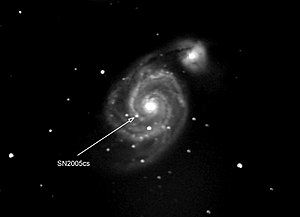
Back Supernova Afrikaans ሱፐርኖቫ Amharic Supernova AN अधिनवतारा ANP مستعر أعظم Arabic سوبرنوڤا ARZ Supernova AST İfrat yeni ulduz Azerbaijani Звышновая зорка Byelorussian Свръхнова Bulgarian

A supernova is the explosion of a giant star. It usually happens when the nuclear fusion in the star cannot hold the core against its own gravity.[1] The core collapses, and then explodes.
The biggest stars that make supernovae are hypergiants and smaller ones are supergiants. They are massive: because of gravity, they use up their energy very quickly. Normally they only live for a few million years.
During the explosion, the total energy radiated by supernovae may briefly outshine the entire output of a galaxy. They emit energy equal to that of the whole lifetime of a solar-like star.[2] The explosion blows off its stellar material away from the star, at velocities up to 30,000 km/s or 10% of the speed of light.[3] This drives a shock wave into the surrounding interstellar medium. This sweeps up an expanding shell of gas and dust, which we see as a supernova remnant. After exploding, what is left becomes a black hole or a neutron star.
Most stars are small and do not explode. After their red giant phase, they become colder and smaller and become white dwarf stars.[4]
Supernova explosions happen rarely. The last time people saw a supernova in our own galaxy, the Milky Way, was in the year 1604. We can see supernovas in other galaxies too. Every year we see 300 supernovas in other galaxies, because there are so many galaxies. Sometimes they are brighter than the whole rest of the galaxy.
- ↑ This is the cause of all types of supernova except type Ia.
- ↑ Giacobbe, Frederick W. 2005. How a Type II supernova explodes. Electronic Journal of Theoretical Physics 2 (6): 30–38. [1]
- ↑ Heger, Alexander et al 2003. How massive single stars end their life. Astrophysical Journal. 591: 288. [2]
- ↑ Tyler, Pat (26 June 2003). "Supernova". NASA HEASARC: Education and Public Information. Retrieved 29 January 2013.
© MMXXIII Rich X Search. We shall prevail. All rights reserved. Rich X Search